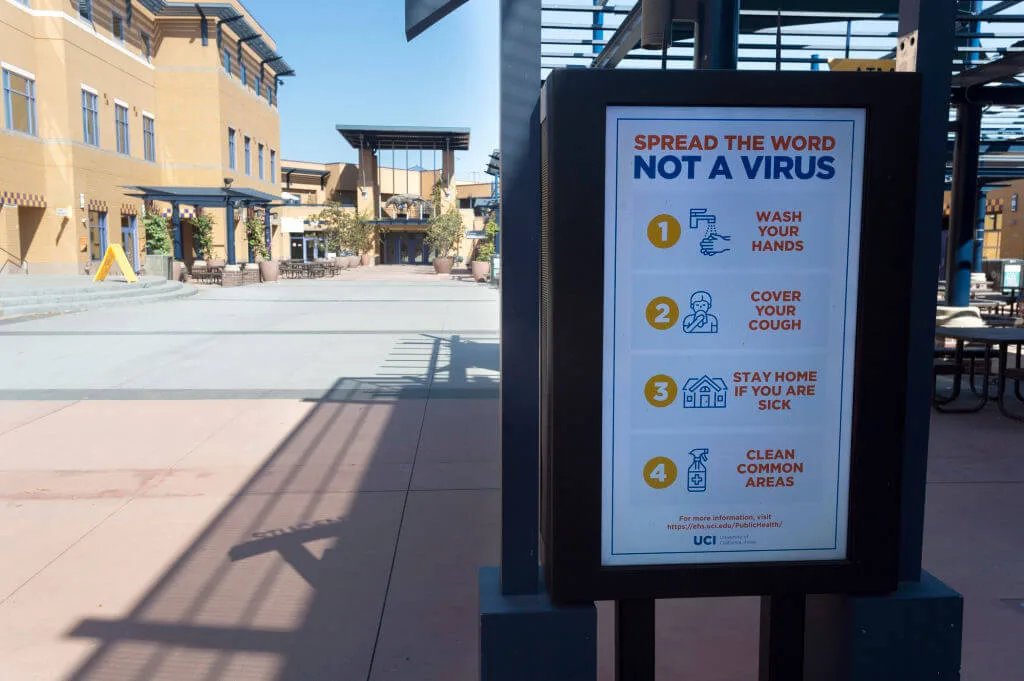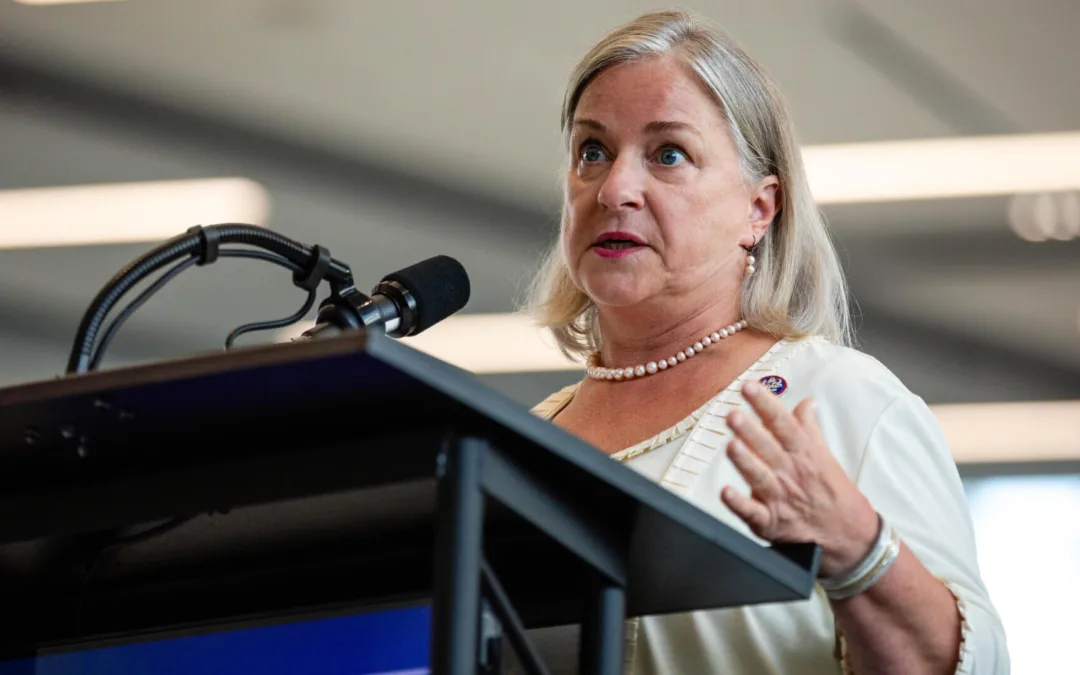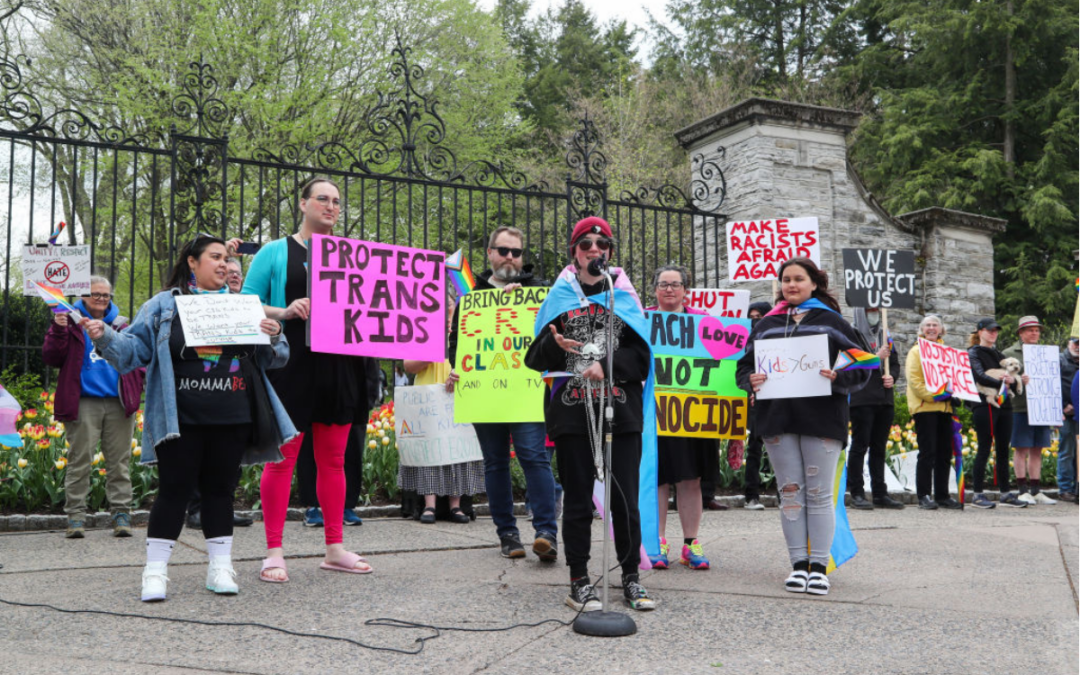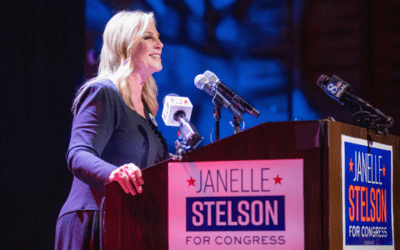
A sign describes safety precautions on a mostly empty campus at the University of California, Irvine in Irvine, CA on Friday, October 2, 2020. Classes started Thursday, October 1st but most are online, leaving few students on campus due to COVID-19 (coronavirus) restrictions. (Photo by Paul Bersebach/MediaNews Group/Orange County Register via Getty Images)
Federal student aid applications are down by nearly 100,000, a drop of four percentage points, as the coronavirus pandemic continues.
With the fall semester in full swing among colleges and universities across the country, a concerning shift in student enrollment is abundantly clear for the 2020-21 school year: low-income students simply aren’t enrolling, period. They’re also the most likely to drop out of school right now, due to the coronavirus pandemic and the ongoing economic crisis.
A US Census Bureau report from August shows students whose families make less than $75,000 a year are nearly twice as likely as those whose families make more than $100,000 per year to say they have dropped their fall classes altogether.
That trend also extends to college applications. Almost 100,000 fewer high school seniors completed financial aid applications to attend college during this school year, according to Free Application for Federal Student Aid (FAFSA) data analyzed by the National College Attainment Network (NCAN), a drop of four percentage points. The data surrounding low-income students is troubling, according to Bill DeBaun, data director for NCAN.
“There has been a disproportionate impact on students from low-income backgrounds in terms of not completing a FAFSA for the first time,” DeBaun told COURIER. “And, yes, that is going to have an impact on postsecondary enrollment.”
Lower-income Americans, particularly minorities, have suffered higher rates of unemployment during the pandemic. Minorities are also contracting COVID-19 at a higher rate. These life-altering circumstances are having a drastic, direct impact on college enrollment—with no end in sight.
“You have a lot of families who don’t have broadband internet access at home,” DeBaun explained. “Or they don’t have a home environment conducive to learning. You know, they’re sharing bedrooms with siblings or other family members. There might not be a suitable study space. All of these things impact the individual educational experience.”
The COVID-19 pandemic and physical distancing that comes with it makes the financial recession of 2008 not comparable to what’s happening today. During that particular economic downturn, enrollment in post-secondary institutions increased—jobs were hard to come by, but people turned to colleges and universities to forge new paths and discover new skills to increase their prospects.
This time, things are much different.
“Although the economic situation in 2008 was very bad, the access to educational institutions was never in doubt,” DeBaun said. “You could physically access those campuses. You could go to class. The challenge here is that you can’t even get to campus in many cases. And students aren’t getting a price discount to attend virtually.”
Widespread job insecurity and high national unemployment rates are likely the direct cause of dropping enrollment numbers among college students from low-income families. Unfortunately, colleges and universities haven’t cut the price tag for tuition this fall. Many schools are dealing with budget constraints that have led to layoffs, furloughs, and pay cuts for staff. Offering a tuition discount for students attending virtually could deepen the financial crisis for postsecondary institutions, but failing to offer financial assistance or relief for students could mean losing low-income students for several years.
The Washington Post reported that many students have dropped out of college this fall because of virtual classes. The environment of in-person classes cannot be aptly recreated virtually, and in addition to finding reliable internet access and a quiet place to study, many students expressed frustration with communication barriers to teachers, fellow students, and support staff.
Solutions to this burgeoning enrollment problem are limited at the moment, as the economic impact of the pandemic continues to unfold. DeBaun suggested said virtual walk-throughs on how to fill out the FAFSA applications, which can be daunting for parents and guardians to tackle, is one way to narrow the gap.
“There are program models across the country that are available, and many areas are making a particular effort to make the pivot at the state level,” he said.
In Washington state, for example, they have a program called ‘Otterbot.’ It’s a free, AI-powered texting service that helps high school seniors apply for financial aid for college and other training programs. Arizona has “Benji,” a similar AI program that helps students get answers to their FAFSA questions instantly via text. DeBaun said most programs like these have real people available to speak to if the bots are unable to answer the questions.
“With everything being virtual right now, these are the kinds of practices that we’re seeing that are that are trying to fill the gap for what would otherwise be in-person interactions,” he said. It might not solve the underlying financial and health-related issues impacting the enrollment dilemma, but offering families and students direct, one-on-one assistance when applying for financial aid 24/7 will hopefully prove to be a valuable resource.
The first available data for the 2021-2022 school year FAFSA completion is just beginning to stream in, and DeBaun said NCAN plans to monitor it closely to try to raise awareness about patterns of inequity.
“We’ll continue to try to call attention to the matter for both the public and for policymakers.”

For Rep. Susan Wild, supporting PA families includes reproductive rights and much more
Rep. Susan Wild wants to be very clear with Pennsylvanians: Donald Trump is committed to taking away women’s reproductive freedom, but he is not...

School districts working with anti-LGBTQ groups can cost your kids’ schools millions
Parents across South Central Pennsylvania are worried about the potential financial impacts working with anti-LGBTQ groups may have on their school...

VIDEO: Trump distances himself from his anti-abortion views
Donald Trump appeared on WGAL on Tuesday and continued to distance himself from his anti-abortion views claiming that reproductive rights are now a...

VIDEO: Community pushback gets school board to rescind decision on denying gay actor’s visit
Cumberland Valley School Board offered a public apology and voted to reinstate Maulik Pancholy as a guest speaker a week after the board voted to...

VIDEO: Project 2025 brings nuclear armageddon back into vogue
Project 2025 is a titanic document, with plans ranging from cutting half of all government employees to targeting reproductive rights on a scale...




